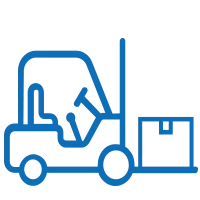With complex equipment, tight spaces, and constant movement, the risks when carrying out materials handling operations in warehouses are real and ever-present. However, by combining the correct forklift training with fleet management solutions and operator assistance systems, warehouses can support safety standards while also improving operational efficiency.
Here are 11 actionable forklift safety tips, grounded in real-world challenges and supported by innovative approaches, which may help you safeguard your workforce and your warehouse.
1. Only correctly trained operators should use lift trucks
A comprehensive training programme that includes the tools needed to customise training to the specific site and trucks can help operations deliver fully compliant training in line with local regulations (which may vary).
Forklift telemetry can also play a key role. Solutions such as Yale Vision include operator access controls where key cards can be used to limit equipment access to only operators with the proper certification and training, and track performance and training expiration dates for each operator.
2. Conduct pre-use forklift checks
Before operating a lift truck, operators should examine it for indications of anything which would make it unsafe to operate. Pre-shift checks, also known as pre-use inspections, may also be required by local safety legislation.
Digital safety checklists are a lift truck technology which can disable truck use until the operator has completed the standard pre-shift checklist or other specific industry mandated checklists. This feature is available with the Yale Vision telematics solution.
3. Use seatbelts and seats correctly
Robust training and certification programmes can educate operators on requirements such as fastening the seat belt before operating the lift truck, where applicable, and that it is dangerous for anyone to ride anywhere on the lift truck except in designated seating areas.
Completing digital safety checklists, as previously mentioned, can require operators to confirm that the seat belt is working properly before operating the lift truck. An impact camera, such as the Yale Vision Impact Camera, can also sync with telemetry detection systems so when a critical impact occurs, video footage, with front and rear panoramic views, of the moments before and after a critical impact is automatically saved. This enables operations to get to the root cause of what happened, and take preventative action.
4. Don’t exceed the rated load - ensure it is stable and balanced
Training helps educate operators on the importance of never exceeding the rated weight of the lift truck and the potential consequences of picking up an overweight, unstable, or unbalanced load. In addition, operator assistance systems (OAS) may provide extra support in particular applications. For example, the overload arrest function of the Yale Reliant OAS suite can restrict lift functionality when an operator attempts to lift a load that exceeds a truck’s rated capacity. Likewise, an advanced dynamic stability feature like adaptive fork and load control can automatically adjust lift and lower speeds, mast height, tilt range, tilt speed and reach extension speed to minimise the potential for the handling of the load to upset lift truck stability.
5. Maintain safe clearances
Training should cover the importance of maintaining proper clearance at all times. In some operations, operator assistance solutions like Yale Reliant may also be implemented.
Real-time location sensing capabilities like fork height restriction can proactively alert operators of low overhead clearance by limiting truck travel speed and mast lifting speed until the operator has lowered the forks beneath the designated threshold or the truck exits the height restricted zone.
Some systems can also detect obstacles and support operator awareness by automatically and noticeably reducing the speed of the lift truck. Detection can include obstacles in the path of travel or badged pedestrians and equipment in close proximity, or both, based on selected detection technology.
In the case of maintaining clearance in the warehouse, end-of-aisle slowdown can proactively reduce travel speed of the truck at the end of an aisle, based on rules set by the operation, helping remind operators of their training and of proper operating practices. Object detection can reduce travel speed when another truck is detected in the path of travel and proximity detection can do so when a truck equipped with ultrawideband technology is nearby.
Leveraging location data from forklift telemetry systems can also help identify efficient routes and areas prone to impacts to influence facility layout and traffic pattern changes to provide a solution for problem areas.
6. Pick up, put down, and stack safely
Following safe procedures for picking up, putting down and stacking loads is a basis for forklift operator training. Assistive technologies are not designed to replace these operator skills and knowledge. However, they may add additional support and provide a layer of confidence for less experience operators.
OAS may include lift/lower soft stops that can control lift and lower acceleration and deceleration to avoid loads being lowered too quickly and risking fragile products being ‘slammed’ onto the floor.
Mast lift and lower control can manage mast speed to avoid loads being raised or lowered too quickly and potentially causing the mast to sway. Tilt speed and range control can limit mast tilt speed and range when a load is in an unfavourable tilt position, and tilt soft stop can manage tilt control to avoid sharp stops that could upset load and truck stability.
7. Keep a safe distance
During forklift training, operators are typically taught the hazards of tip overs and falling off docks, and learn the importance of keeping a safe distance. Keeping away from platform, ramp, and loading dock edges, and never backing up a forklift to the dock’s edge, is typical best practice.
This best practice can be backed up with OAS like Yale Reliant. Real-time location sensing functions like speed control zones can proactively reduce truck travel speed when operators enter specific designated areas designated to help promote correct operator behaviour, while exclusion zones can proactively reduce travel speed to a very low rate to discourage operators from moving through certain designated areas in the facility at all.
8. Observe the speed limit and avoid pedestrians
Rules around pedestrian traffic can differ widely from facility to facility. However, forklift training programmes should include pedestrian interactions with forklifts and unique site-specific rules such as right-of-way and speed limits. Sounding a horn at cross aisles and in obstructed areas is a basic element of forklift operation that is covered in training and may help improve awareness between pedestrians and lift trucks.
However, some warehouses may choose to implement object detection assistance systems which can reduce travel speed when a pedestrian is detected in the path of travel. With Yale Reliant, proximity detection can also do so when a pedestrian equipped with an ultrawideband badge is nearby, even if they are obscured from the operator’s view, such as individuals in an aisle.
9. Slow down in congested or slippery areas
Correct forklift training should cover the need for operators to know when to slow down to match their surroundings, including congestion and slippery surfaces. And this is another area where speed control zones can be helpful. This technology can proactively limit the travel speed in locations such as heavily populated areas or crosswalks that have been identified by site-management as zones where special speed control is desired.
10. Follow maintenance and repair recommendations
Maintaining and repairing vehicles in accordance with manufacturers’ recommendations is not just about compliance. Modifications or additions to the forklift can also affect capacity and safe operation. Fleet management tools, such as Yale Vision telemetry, may help support planned maintenance programmes. Access to certified technicians same-day or even outside typical business hours can also help maintenance and repairs to be completed in accordance with manufacturer standards, quickly. The network of independent Yale dealers can support warehouses with this, empowering operations with confidence and greater uptime.
11. Don’t use forklifts in unsafe condition
Pre-use checks or inspections for forklifts is typically covered in the foundational level of forklift training. But how to conduct these checks is just one part. Whether they use a paper checklist, or a digital checklist in a tool like Yale Vision, operators must also feel that they can remove forklifts from service if they do not pass any aspect of the required inspection.
Sometimes, an issue does not present itself until later, when a forklift is in use. Engine, transmission, hydraulic and electric system monitoring can trigger automated service calls. Lift truck telemetry systems may also include an impact lockout solution, which protects equipment from prematurely returning to operation following a critical impact event.
Take the next step towards forklift safety in the warehouse
Learn more about solutions and technologies to help improve your approach to safety within your warehouse and lift truck operations by speaking to a local, independent Yale dealer.
*Based on internal measurements between the two mast channels compared to the Linde E3.0, TCM/CAT/Mitsubishi FHB25 and Toyota 9FMB25T. Measurements taken in March 2023.


